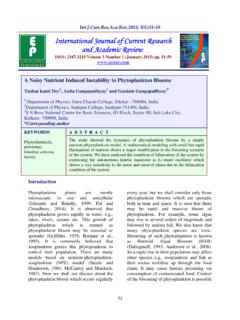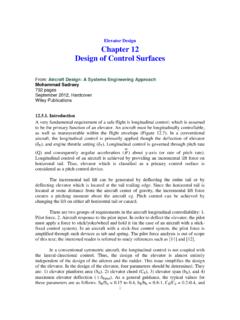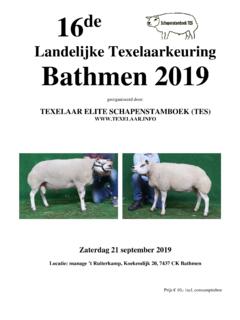Transcription of THE FOKKER-PLANCK EQUATION - Imperial College London
1 THE FOKKER-PLANCK EQUATION . Existence and Uniqueness of Solutions for the FP EQUATION Consider a diffusion process on Rd with time-independent drift and diffusion coefficients. The FOKKER-PLANCK EQUATION is Xd d p 1 X 2. = (ai (x)p)+ (bij (x)p), t > 0, x Rd , t j=1. xj 2 i,j=1 xi xj (1a). p(x, 0) = f (x), x Rd . (1b). Write it in non-divergence form: d d p X p 1 X 2p = a j (x) + b ij(x) +c (x)u, t > 0, x Rd , t j=1. xj 2 i,j=1 xi xj (2a). p(x, 0) = f (x), x Rd , (2b). Existence and Uniqueness of Solutions for the FP EQUATION where d X d d bij 1 X 2 bij X ai a i (x) = ai (x) + , c i (x) = . j=1. xj 2 i,j=1 xi xj i=1. xi The diffusion matrix is always nonnegative. We will assume that it is actually positive, we will impose the uniform ellipticity condition: d X.
2 Bij (x) i j > k k2 , Rd , (3). i,j=1. Furthermore, we will assume that the coefficients a , b, c are smooth and that they satisfy the growth conditions kb(x)k 6 M, ka (x)k 6 M (1 + kxk), kc (x)k 6 M (1 + kxk2 ). (4). Existence and Uniqueness of Solutions for the FP EQUATION We will call a solution to the Cauchy problem for the fokker Planck EQUATION (2) a classical solution if: i) u C 2,1 (Rd , R+ ). ii) T > 0 there exists a c > 0 such that kxk2. ku(t, x)kL (0,T ) 6 ce iii) limt 0 u(t, x) = f (x). Existence and Uniqueness of Solutions for the FP EQUATION Theorem 1. Assume that conditions (3) and (4) are satisfied, and kxk2. assume that |f | 6 ce . Then there exists a unique classical solution to the Cauchy problem for the fokker Planck EQUATION .
3 Furthermore, there exist positive constants K, so that . 1. |p|, |pt |, k pk, kD2 pk 6 Kt( n+2)/2 exp kxk2 . 2t This estimate enables us to multiply the FOKKER-PLANCK EQUATION by monomials xn and then to integrate over Rd and to integrate by parts. The FP EQUATION as a conservation law We can define the probability current to be the vector whose ith component is d 1X . Ji := ai (x)p bij (x)p . 2 j=1 xj The fokker Planck EQUATION can be written as a continuity EQUATION : p + J = 0. t Integrating the FP EQUATION over Rd and integrating by parts on the right hand side of the EQUATION we obtain Z. d p(x, t) dx = 0. dt Rd Consequently: kp( , t)kL1 (Rd ) = kp( , 0)kL1 (Rd ) = 1. Examples of Diffusion Processes Set a(t, x) 0, b(t, x) 2D > 0. The FOKKER-PLANCK EQUATION becomes: p 2p = D 2, p(x, s|y, s) = (x y).
4 T x This is the heat EQUATION , which is the FOKKER-PLANCK EQUATION for Brownian motion (Einstein, 1905). Its solution is 2.. 1 (x s). pW (x, t|y, s) = p exp . 2 D(t s) 2D(t s). Examples of Diffusion Processes Assume that the initial distribution is pW (x, s|y, s) = W (y, s). The solution of the FOKKER-PLANCK EQUATION for Brownian motion with this initial distribution is Z. PW (x, t) = p(x, t|y, s)W (y, s) dy. The Gaussian distribution is the fundamental solution (Green's function) of the heat EQUATION ( the FOKKER-PLANCK EQUATION for Brownian motion). Examples of Diffusion Processes Set a(t, x) = x, b(t, x) 2D > 0: p (xp) 2p = + D 2. t x x This is the FOKKER-PLANCK EQUATION for the Ornstein-Uhlenbeck process (Ornstein-Uhlenbeck, 1930). Its solution is r (t s) 2.
5 (x e y). pOU (x, t|y, s) = 2 (t s). exp 2 (t s).. 2 D(1 e ) 2D(1 e ). Proof: take the Fourier transform in x, use the method of characteristics and take the inverse Fourier transform. Examples of Diffusion Processes Set y = 0, s = 0. Notice that lim pOU (x, t) = pW (x, t). 0. Thus, in the limit where the friction coefficient goes to 0, we recover distribution function of BM from the DF of the OU. processes. Notice also that r 2.. x lim pOU (x, t) = exp . t + 2 D 2D. Thus, the Ornstein-Uhlenbeck process is an ergodic Markov process. Its invariant measure is Gaussian. We can calculate all moments of the OU process. Examples of Diffusion Processes Define the nth moment of the OU process: Z. Mn = xn p(x, t) dx, n = 0, 1, 2, .. R. Let n = 0. We integrate the FP EQUATION over R to obtain: Z Z Z 2.
6 P (xp) p = +D 2. = 0, t x x after an integration by parts and using the fact that p(x, t). decays sufficiently fast at infinity. Consequently: d M0 = 0 M0 (t) = M0 (0) = 1. dt In other words: d kpkL1 (R) = 0 p(x, t) = p(x, t = 0). dt Consequently: probability is conserved. Examples of Diffusion Processes Let n = 1. We multiply the FP EQUATION for the OU process by x, integrate over R and perform and integration by parts to obtain: d M1 = M1 . dt Consequently, the first moment converges exponentially fast to 0: M1 (t) = e t M1 (0). Examples of Diffusion Processes Let now n > 2. We multiply the FP EQUATION for the OU. process by xn and integrate by parts (once on the first term on the RHS and twice on the second) to obtain: Z Z Z. d xn p = n xn p + Dn(n 1) xn 2 p.
7 Dt Or, equivalently: d Mn = nMn + Dn(n 1)Mn 2 , n > 2. dt This is a first order linear inhomogeneous differential EQUATION . We can solve it using the variation of constants formula: Z t Mn (t) = e nt Mn (0) + Dn(n 1) e n(t s) Mn 2 (s) ds. 0. Examples of Diffusion Processes The stationary moments of the OU process are: r Z. n n x 2. hx iOU = x e 2D dx 2 D R. n .. (n 1) D n/2 , n even, . =. 0, n odd. We have that lim Mn (t) = hxn iOU . t . If the initial conditions of the OU process are stationary, then: Mn (t) = Mn (0) = hxn iOU . Examples of Diffusion Processes set a(x) = x, b(x) = 12 x2 . This is the geometric Brownian motion. The generator of this process is 2 x2 2. L = x + 2.. x 2 x Notice that this operator is not uniformly elliptic. The FOKKER-PLANCK EQUATION of the geometric Brownian motion is.
8 P 2 2 x2. = ( x) + p . t x x2 2. Examples of Diffusion Processes We can easily obtain an EQUATION for the nth moment of the geometric Brownian motion: d 2 . Mn = n + n(n 1) Mn , n > 2. dt 2. The solution of this EQUATION is 2. ( +(n 1) 2 )nt Mn (t) = e Mn (0), n>2. and M1 (t) = e t M1 (0). Notice that the nth moment might diverge as t , depending on the values of and : . 2 .. 0, 2 < n 1 , lim Mn (t) = 2 . Mn (0), 2 = n 1 , t .. 2 . + , 2 > n 1 . Gradient Flows Let V (x) = 12 x2 . The generator of the OU process can be written as: L = x V x + D x2 . Consider diffusion processes with a potential V (x), not necessarily quadratic: L = V (x) + D . (5). This is a gradient flow perturbed by noise whose strength is D = kB T where kB is Boltzmann's constant and T the absolute temperature.
9 The corresponding stochastic differential EQUATION is . dXt = V (Xt ) dt + 2D dWt . Gradient Flows The corresponding FP EQUATION is: p = ( V p) + D p. (6). t It is not possible to calculate the time dependent solution of this EQUATION for an arbitrary potential. We can, however, alwas calculate the stationary solution. Gradient Flows Proposition 1. Assume that V (x) is smooth and that e V (x)/D L1 (Rd ). (7). Then the Markov process with generator (5) is ergodic. The unique invariant distribution is the Gibbs distribution 1 V (x)/D. p(x) = e (8). Z. where the normalization factor Z is the partition function Z. Z= e V (x)/D dx. Rd Gradient Flows The fact that the Gibbs distribution is an invariant distribution follows by direct substitution.
10 Uniqueness follows from a PDEs argument (see discussion below). It is more convenient to normalize the solution of the FOKKER-PLANCK EQUATION wrt the invariant distribution. Proposition 2. Let p(x, t) be the solution of the FOKKER-PLANCK EQUATION (6), assume that (7) holds and let (x) be the Gibbs distribution (8). Define h(x, t) through p(x, t) = h(x, t) (x). Then the function h satisfies the backward Kolmogorov EQUATION : h = V h + D h, h(x, 0) = p(x, 0) 1 (x). (9). t Gradient Flows Proof. The initial condition follows from the definition of h. We calculate the gradient and Laplacian of p: p = h hD 1 V. and p = h 2 D 1 V h + hD 1 V + h| V |2 D 2 . We substitute these formulas into the FP EQUATION to obtain h . = V h + D h , t from which the claim follows.










